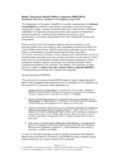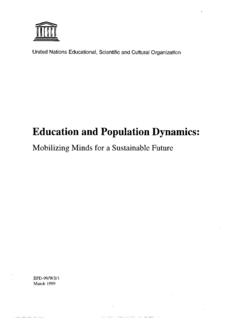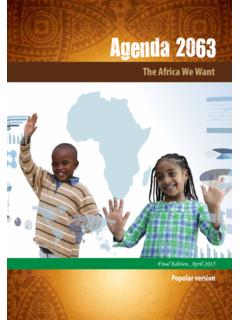Transcription of Great to Excellent - Michael Fullan
1 Great to Excellent : Launching the Next Stage of Ontario s education agenda Page 1 Introduction. In 2003 Ontario s schools were in a troubled state. The achievement of students was good but flat lined stagnant results year after year. Morale of teachers was low; the schools as a whole could be characterized as loosely-coupled and without focus. The system was downtrodden. Now in early 2013, the overall performance of the almost 5,000 schools in the province has dramatically improved on most key measures, and continues to improve. According to international measures and independent expert assessment, Ontario is recognized as and is proven to be the best school system in the English-speaking world and right up at the top with Finland, Singapore and South Korea.
2 As Premier Dalton McGuinty leaves office, in this paper we will review key aspects of the journey, and set the tasks for the next phase. Nine years of steady improvement is impressive. This is a long time for a system to sustain success. Going from good to Great has not been easy. But past experience with large-scale reform suggests it would be all too possible to falter at this stage. The biggest obstacle to further success is the self-satisfaction with what we have accomplished. There is much more to do in going forward. What is needed is a focused launch to the next level of performance. Only a sustained commitment to doing better will keep our global leadership in place. Ontario unequivocally has developed from good to Great .
3 But we are now at a crucial stage as we head for 2013 and beyond. Will we stand still or worse, fall behind while the rest of the world passes us by? Or will we take the necessary steps to build on our success and move from Great to Excellent ? Let us also note that while there are serious financial constraints, this journey to excellence can be accomplished within the resources that will be available. We must at the same time realize that much more needs to be done to improve on what we have accomplished. We have been successful because of the deep professionalism of educators across the entire system. No system in the world has progressed without strong rapport between the government and its teachers and principals.
4 Without a partnership of working together, we will almost certainly recede in a world where other systems are pushing toward excellence. Great to Excellent : Launching the Next Stage of Ontario s education agenda Page 2 Greatness is the enemy of excellence because it is easy to be complacent, and take things for granted. So, what have we accomplished? And equally important, how do we sustain improvement as well as go beyond it into new levels of learning through focused innovations? Let s see what is at stake and what can be done. What Has Been Accomplished? (2003-2012) Behind the obvious achievements of increased literacy, numeracy, and high school graduation rates, not to mention the benefits of early learning, lies the real strength of the accomplishment of the last nine years the deep, widely shared ownership on the part of teachers, schools and school board leaders of the reform agenda .
5 We will consider the actual accomplishments shortly, but it is significant that at least three prominent international bodies have studied Ontario up close and all found that it is a powerful example of a government deliberately setting out to improve the whole system, and having the results to show for it. These include the OECD in Paris, which conducts the internationally respected PISA assessments of 15-year-olds in literacy, numeracy, and science in 70 countries across the world; the McKinsey group, which carried out two world-wide studies on education system performance; and the National Center for education and the Economy (NCEE) in the (see references). The OECD commissioned a team from Harvard to study what we have done, calling its report Strong Performers and Successful Reformers in education .
6 NCEE went further when it named its report Standing on the Shoulders of Giants, urging the to emulate what we have done. Scores of delegations come to Ontario each year and all end up admiring what we they see. As to the results themselves, literacy and numeracy with very high standards at play have improved from 54 per cent to 70 per cent on average across the province s 4,000 elementary schools as measured by the education Quality and Accountability Office (EQAO). EQAO measures and teacher diagnostic assessments in the classroom have become more congruent. Put another way, teachers who conduct good personalized assessments in their classrooms and take corresponding actions predictably see their assessment scores increase.
7 When whole schools do this, the results are phenomenal. Great to Excellent : Launching the Next Stage of Ontario s education agenda Page 3 Secondary school reform commenced almost two years after the initiatives in the elementary schools. The innovations in high schools with the Student Success/ Learning to 18 Strategy, the focus on literacy in grades 9 and 10, and the new Specialist High Skills Major programs that have flourished have been an amazing success. Graduation rates have improved by about two per cent every year, bringing the province s 900 high schools to an 82 per cent graduation rate from its starting point of 68 per cent. We can express these accomplishments in different terms.
8 There are 125,000 elementary students who have higher proficiency in reading and writing than would have been the case without the strategy; a further 93,000 students graduated from high school because of the strategy; and the gap between special education students and other students has been reduced by over eight per cent, another finding from an external research group. Immigrants who don t speak English when they arrive have also risen rapidly to reduce the gap compared to others. The percentage of students performing at level 1 or below has declined from 17 per cent to less than six per cent at the present time. The number of low-performing elementary schools eligible for the turnaround program the Ontario Focused Partnership Program has been reduced from its starting high of 800 schools to its current low of 87 schools, even though the bar has been set even higher.
9 And so it goes, no matter how you cut it steady progress on most measures. What really sticks with the external researchers and the numerous site visitors to our schools from all over the world is what they see and hear when they visit schools. They can go into almost any school in the province and they will find consistency of good practice. When they ask teachers or principals to explain what they are doing and why, they get specific and widely shared answers. Educators can point to particular actions and show the link to student learning. They know where each and every student is on the learning journey. The degree to which the new and better practices have spread across the province is incredible to people who come from systems that struggle to maintain a focus.
10 External observers see the consistency in the views among the stakeholders, from unions and teachers to principals and parents they all tell the same story. Even the Finns are impressed. Another domain of substantial progress is full-day kindergarten (FDK). We take this up later in the section on focused innovation because the impact of FDK has not Great to Excellent : Launching the Next Stage of Ontario s education agenda Page 4 yet been realized. But the progress to date is substantial. In quantitative terms as of 2012, we have 50 per cent of all students covered (125,000). In 2013, it will be 75 per cent. By September 2014, all 250,000 4- and 5-year-olds will be in full-day kindergarten, the first program of its kind in North America There is widespread satisfaction among parents, teachers, school and school board leadership, and trustees.









